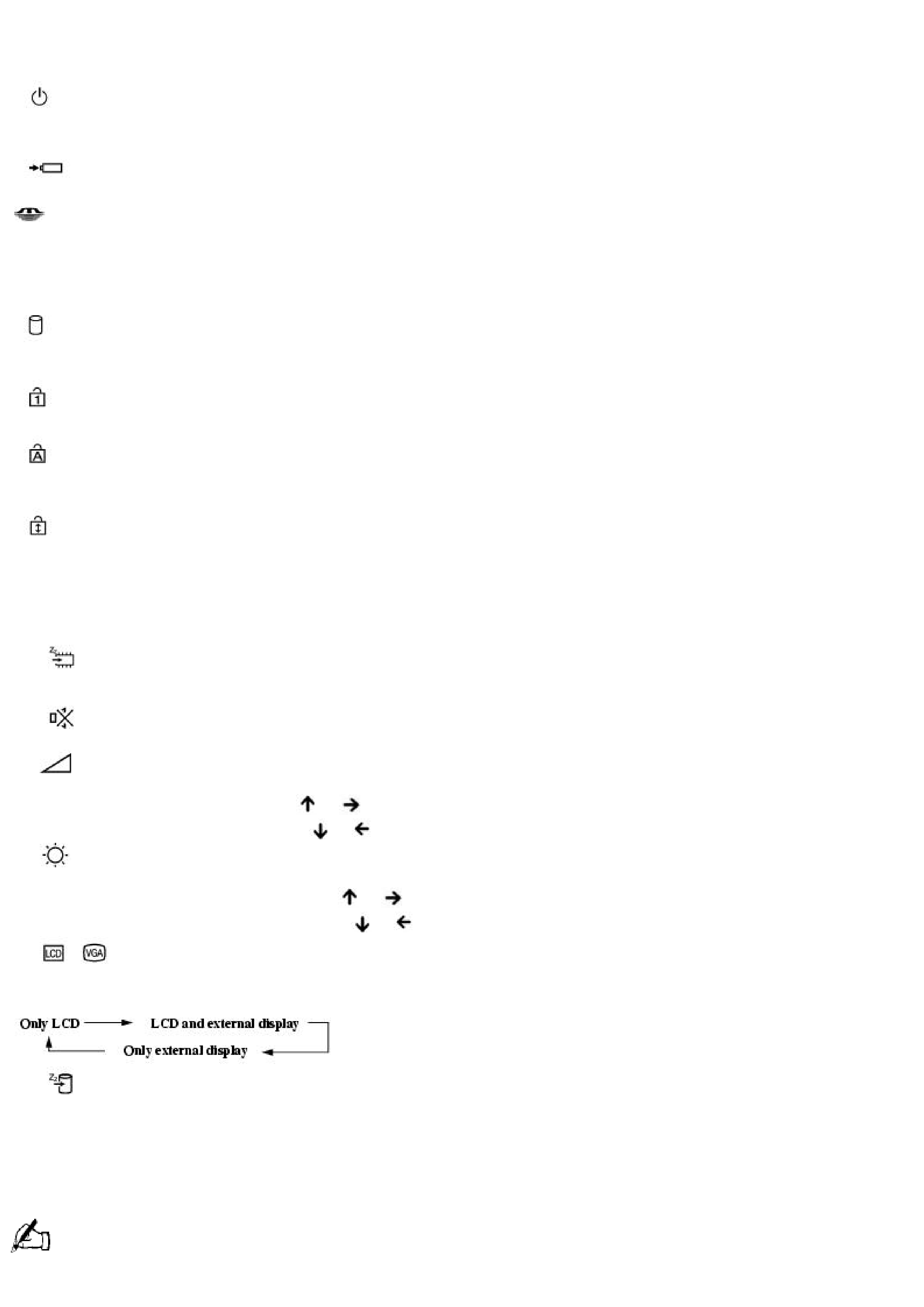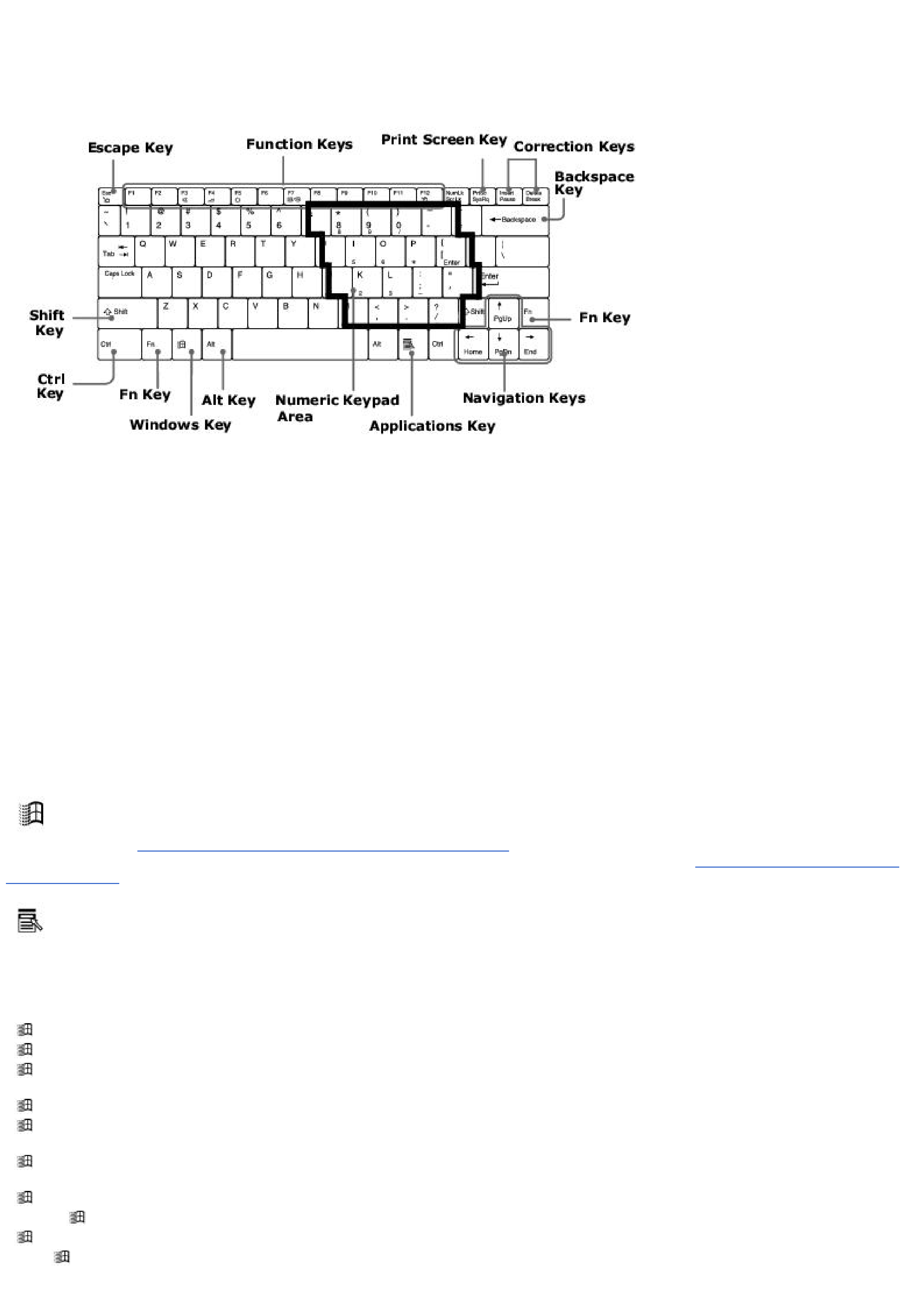
Welcome
Congratulations on your purchase of the Sony VAIO® computer, and welcome to the VAIO® Notebook User Guide.
This user guide provides detailed information on all aspects of using your new VAIO computer, from keyboard
functions to preinstalled software applications. In the left navigation window, click the topics you want to learn more
about, and that information will be displayed in this main window.
Page 1

Using Your VAIO Notebook
This section describes the following aspects of your computer:
Using the Keyboard
Using the Touchpad
Using the Optical Drive
Using PC Cards
Connecting VAIO Computers
Using the Jog Dial Control
VAIO Action Setup
Using Memory Stick Media
Using Power Saving Modes
Using the Modem
Connecting a Phone Line
Connecting to a Local Area Network
Page 2

Using the Keyboard
Your keyboard is very similar to that of a typewriter, but the keyboard has additional keys that perform specific
computer-related tasks.
Keyboard
Functions of the keyboard keys
Key
Description
Numeric keypad area Contains the keys found on a typical calculator. Use the numeric keypad area to type numbers or to
perform mathematical calculations such as addition and subtraction. Note that you must press the Num Lock key to activate
the numeric keypad. (When you do so, the Num Lock indicator will be on.) Press the Num Lock key again to deactivate it.
Navigation keys
The Left/Right/Up/Down arrows are devoted to move the cursor on the screen and also function as
the Home, End, Page Up, and Page Down keys, respectively.
Correction keys
The Insert, Back Space, and Delete keys enable you to make corrections in your documents.
Function keys
The 12 function keys along the top of the keyboard are used to perform designated tasks. For example, in
many applications, F1 is the Help key. The task associated with each function key may vary from one application to the
next.
Escape key
The Esc (Escape) key is used to cancel commands.
Print Screen key
The Print Screen key takes an electronic snapshot of the screen and places it in the Windows®
Clipboard. You can then paste the screen shot into a document and print it.
Operator keys Several keys are always used with at least one other key: Ctrl, Alt, and Shift. When held down with another
key, the Ctrl (Control) and Alt (Alternate) keys offer another way to give commands. For example, in many applications,
instead of choosing the Save command from a menu, you can hold down Ctrl and press S (referred to as Ctrl+S). The Shift
key operates the same way as on a typewriter; it is used to produce capital letters or special symbols such as @ and $.
Windows key
The key with the Windows® logo displays the Windows Start menu; it is the equivalent of clicking Start on
the task bar. See Combinations and functions with the Windows key for more information.
Fn key
The Fn keys are used in combination with other keys to issue commands. See Combinations and functions
with the Fn key for more information.
Applications key
The Applications key displays a shortcut menu of context-sensitive choices. Pressing this key is the
equivalent of clicking the right mouse button.
Combinations and functions with the Windows key
Combinations
Functions
+ F1
Displays Windows® Help.
+ Tab
Switches the selected button on the taskbar.
+ D
Minimizes displayed windows temporarily, and desktop is displayed. Pressing this key combination a second
time maximizes windows.
+ E
Displays Windows® Explorer.
+ F
Displays the Windows Find: All Files window to find a file or folder window. This is the equivalent of selecting
Find then Files or Folders from the Start menu.
+ Ctrl + F Displays the Windows Find: Computer window where you can locate other computers. This is the equivalent
of selecting Find then Computer from the Start menu.
+ M
Minimizes all displayed windows.
Shift +
+ M
Returns all minimized windows to their previous size.
+ R
Displays the Run window. This is the equivalent of selecting Run from the Start menu.
Fn +
+ Insert
Displays the System Properties window. This is the equivalent of selecting Control Panel and then
System from the Start menu.
Page 3

Indicators
Indicators
Functions
Power
Light is green when the notebook is powered on, flashes amber when the notebook is in Standby mode,
and turns off when the notebook is in Hibernate mode or is powered off.
Battery
Indicates the status of the battery, which is attached at the rear of the notebook.
Memory Stick
Indicates the Memory Stick® slot is in use.
Indicator lights
Light
On Off
Hard disk
Data is being read from or written to the hard disk drive. Do not enter Standby mode or turn off the
notebook when this indicator is on.
The hard disk drive is not being accessed.
Num Lock
The number keys in the numeric keypad are active.
The character keys in the keypad area are active.
Caps Lock
The letters appear in uppercase as you type. The Shift key lowers the case of typed letters when Caps Lock
is on.
Letters appear in lower case as you type (unless you hold down the Shift key).
Scroll Lock
The screen scrolls differently. (Exactly how it scrolls depends on the specific application. It has no effect in
many applications.)
Information moves across the display normally.
Combinations and functions with the Fn key
Combinations/
Feature
Functions
Fn+
(Esc)
Standby
Puts the system in Standby mode, which is a power management state. To return the system to the active
state, press any key or press the power switch on your notebook.
Fn+
(F3)
Mute on/off
Toggles the built-in speaker off and on.
Fn+
(F4)
Speaker volume
Adjusts the built-in speaker volume as follows:
To increase volume, press Fn+F4, then
or
.
To decrease volume, press Fn+F4, then
or
.
Fn+
(F5)
Brightness control
Adjusts the brightness of the LCD.
To increase light intensity, press Fn+F5 then
or
.
To decrease light intensity, press Fn+F5 then
or
.
Fn+
/
(F7)
Switch to the
external display
Toggles through the LCD, external display, and both LCD and external display.
Fn+
(F12)
Hibernate
Puts the system in Hibernate mode, which is the lowest level of power consumption. When you execute this
command, the states of the system and the peripheral devices are written to the hard disk and the system power is
turned off. To turn the power back on and return the system to the original state, press the power switch on your
notebook.
Fn+B
Mega-Bass switch
Toggles the mega-bass function off and on. This feature is available with headphone only.
You can also carry out these functions using the Jog Dial
control. Some functions are not available until
Windows® launches.
Page 4

Using the Keyboard
Your keyboard is very similar to that of a typewriter, but the keyboard has additional keys that perform specific
computer-related tasks.
Keyboard
Functions of the keyboard keys
Key
Description
Numeric keypad area Contains the keys found on a typical calculator. Use the numeric keypad area to type numbers or to
perform mathematical calculations such as addition and subtraction. Note that you must press the Num Lock key to activate
the numeric keypad. (When you do so, the Num Lock indicator will be on.) Press the Num Lock key again to deactivate it.
Navigation keys
The Left/Right/Up/Down arrows are devoted to move the cursor on the screen and also function as
the Home, End, Page Up, and Page Down keys, respectively.
Correction keys
The Insert, Back Space, and Delete keys enable you to make corrections in your documents.
Function keys
The 12 function keys along the top of the keyboard are used to perform designated tasks. For example, in
many applications, F1 is the Help key. The task associated with each function key may vary from one application to the
next.
Escape key
The Esc (Escape) key is used to cancel commands.
Print Screen key
The Print Screen key takes an electronic snapshot of the screen and places it in the Windows®
Clipboard. You can then paste the screen shot into a document and print it.
Operator keys Several keys are always used with at least one other key: Ctrl, Alt, and Shift. When held down with another
key, the Ctrl (Control) and Alt (Alternate) keys offer another way to give commands. For example, in many applications,
instead of choosing the Save command from a menu, you can hold down Ctrl and press S (referred to as Ctrl+S). The Shift
key operates the same way as on a typewriter; it is used to produce capital letters or special symbols such as @ and $.
Windows key
The key with the Windows® logo displays the Windows Start menu; it is the equivalent of clicking Start on
the task bar. See Combinations and functions with the Windows key for more information.
Fn key
The Fn keys are used in combination with other keys to issue commands. See Combinations and functions
with the Fn key for more information.
Applications key
The Applications key displays a shortcut menu of context-sensitive choices. Pressing this key is the
equivalent of clicking the right mouse button.
Combinations and functions with the Windows key
Combinations
Functions
+ F1
Displays Windows® Help.
+ Tab
Switches the selected button on the taskbar.
+ D
Minimizes displayed windows temporarily, and desktop is displayed. Pressing this key combination a second
time maximizes windows.
+ E
Displays Windows® Explorer.
+ F
Displays the Windows Find: All Files window to find a file or folder window. This is the equivalent of selecting
Find then Files or Folders from the Start menu.
+ Ctrl + F Displays the Windows Find: Computer window where you can locate other computers. This is the equivalent
of selecting Find then Computer from the Start menu.
+ M
Minimizes all displayed windows.
Shift +
+ M
Returns all minimized windows to their previous size.
+ R
Displays the Run window. This is the equivalent of selecting Run from the Start menu.
Fn +
+ Insert
Displays the System Properties window. This is the equivalent of selecting Control Panel and then
System from the Start menu.
Page 5
